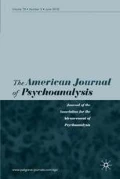Abstract
After describing the role of sensations in the primary levels of mental organization, this part of the article suggests viewing somatic idioms as the language's way to connect with these levels. We seek to exemplify the qualities, meanings and functioning of idioms, since they serve as a basic key in investigating the different layers of the mind. Examples taken from clinical cases, as well as from universal literary products, such as fairy tales, provide useful contributions to this argument.
Similar content being viewed by others
Notes
Neurological research associates the comprehension of idioms with the same network activated during the comprehension of literal sentences—that is, the left super marginal gyros and left middle temporal cortex—suggesting that comprehension of literal and idiomatic sentences share the same core process. This is different from the network activated in figurative language comprehension, in which metaphors are involved. See Papagno 2006.
References
Aleksandrowicz, D. (1962). The meaning of metaphor. Menninger Clinic Bulletin, 26, 92–101.
Arieti, S. (1955). Some aspects of language in schizophrenia. In H. Werner (Ed.), On Expressive Language (pp. 53–67 ). Worcester, MA: Clark University Press.
Billow, R.M. (1977). A review of the psychological literature. Psychological Bulletin, 84, 81–92.
Black, M. (1962). Models and Metaphors. Ithaca, NY: Cornell University Press.
Boatner, M.T. & Gates, J.E. (1975). A Dictionary of American Idioms. New York: Barron's Woodbury.
Breuer, J. & Freud, S. (1895). Studies on hysteria. Standard Edition (Vol. 2, pp. 195–220). London: Hogarth Press, 1955.
Brown, K. (Ed.) (2006). Encyclopedia of Language and Linguistics. Oxford: Elsevier.
Čermák, F. (1982). Idiomatika a frazeologie češtiny. Prague, Czech Republic: Univerzita Karlova Praha.
Čermák, F. (1988). On the substance of idioms. Folia Linguistica, XXII, 413–438.
Čermák, F. (1994). Idiomatics. In P.A. Luelsdorff (Ed.), The Prague School of Structural and Functional Linguistics (pp. 185–196 ). Amsterdam: John Benjamin Publ. Comp.
Cowie, A.P. & Mackin, R. (1975, 1983). The Oxford Dictionary of Current Idiomatic English Vol. 1: Verbs with Prepositions & Particles, Vol. 2: Phrase, Clause and Sentence Idioms. Oxford: Oxford University Press.
Darwin, C. (1952). The Expression of the Emotion in Man and Animals. Chicago, IL and London: University of Chicago Press.
Deutscher, G. (2005). The Unfolding of Language. London: William Heinemann.
Freud, S. (1918). From the history of an infantile neurosis. Standard Edition (Vol. 3, pp. 473–605). London: Hogarth Press.
Freud, S. & Oppenheim, D.E. (1911–1957). Dreams in folklore. Standard Edition (Vol. 12, pp. 175–204). London: Hogarth Press.
Lakoff, G. & Johnson, M. (1980). Metaphors We Live By. Chicago, IL and London: The University of Chicago Press.
Loewenberg, I. (1975). Identifying metaphors. Foundations of Language, 12 (3), 315–338.
Loos, E.E., Anderson, S., Day, D.H., Jordan, P.C. & Wingate, J.D. (Eds.) (2003). Glossary of Linguistic Terms. Ligualinks Library, version 5.0, published on CD-ROM by SIL International.
Masson, J.M. (1985). The Complete Letters of Sigmund Freud to Wilhelm Fliess 1887–1904 (pp. 207–214 ). Cambridge, MA: Belknap Press.
McDougall, J. (1989). Theatres of the Body: A Psychoanalytic Approach to Psychosomatic Illness. New York and London: W. W. Norton.
Papagno, C. (2006). The neural correlated of idiom comprehension: A TMS and an FMRI study. Presentation given at the conference—Architecture of language, Pizza, Italy.
Raufman, R. (2008). The power of a tale. In H. Bar-Itzhak and I. Pintel-Ginsberg (Eds.) The jubilee book of IFA (pp. 142–150 ). Israel: The University of Haifa Press (Hebrew).
Raufman, R. & Yigael, Y. (2010). “Feeling good in your own skin” Part I. Primary levels of mental organization. American Journal of Psychoanalysis, 70, 361–386.
Ricoeur, P. (1980). The metaphorical process as cognition, imagination, and feeling. In S. Sheldon (Ed.), On Metaphor (pp. 141–157 ). Chicago, IL and London: The University of Chicago Press.
Searles, H. (1962). The differentiation between concrete and metaphorical thinking in the recovering schizophrenic patient. Journal of the American Psychoanalytic Association, 10, 22–49.
Swanson, D.R. (1980). Toward a psychology of metaphor. In S. Sheldon (Ed.), On Metaphor (pp. 161–164 ). Chicago, IL and London: The University of Chicago Press.
Tversky, A. (1977). Features of similarity. Psychological Review, 84, 112–115.
Yigael, Y. (2001). Dual identification and the “weight of responsibility”. Psychoanalysis and Contemporary Thought, 24 (2), 175–202.
Author information
Authors and Affiliations
Corresponding author
Additional information
1Ph.D., Lecturer, The University of Haifa, Israel, and a clinical psychologist.
Rights and permissions
About this article
Cite this article
Raufman, R., Yigael, Y. “Feeling Good in Your Own Skin” Part II: Idiomatic Expressions – The Way Language Connects to the Primary Levels of Mental Organization. Am J Psychoanal 71, 16–36 (2011). https://doi.org/10.1057/ajp.2010.33
Published:
Issue Date:
DOI: https://doi.org/10.1057/ajp.2010.33




